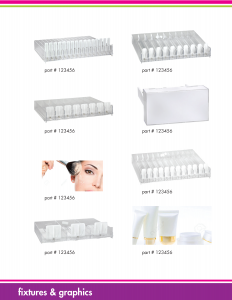From the desk of Julie Massey, visual assets manager, for the Focus on Fixtures blog series
We have a number of ways we can help stores, brands, and even wholesale distributors in their efforts to update departments and set or reset store fixtures. In addition to project management and creating the fixture planograms,  product planograms, and a website, we can produce support materials to help direct and instruct store associates in installation.
product planograms, and a website, we can produce support materials to help direct and instruct store associates in installation.
In my post about assembly materials and videos, I covered several formats (videos, mini-guides, instruction manuals) that can be used to create support collateral. One of the formats I mentioned was a merchandising guide, like one we created for a cosmetics brand.
In that merchandising guide there is a fixture planogram with products, a line listing, product pictures, and the required fixture pieces, such as inserts, trays, hooks, etc. We created these specific guides for the various retailers in which the brand has product, and update them as seasonal resets take place.
In addition, we created a different kind of merchandising guide for a distributor client of ours that provides category management tools for their independent pharmacy clients. This merchandising guide is produced monthly and includes featured new items and a new item listing. It is sent on a monthly basis along with a planogram booklet that covers 1-2 departments and offers merchandising tips, category information, different size planograms, line listings, and a flowgram. Signs and a new item brief are also provided.
For this same distributor we produce a theme-based seasonal guide four times a year to optimize the store endcaps so their merchandisers can highlight products that might peak in popularity at a particular time of year. Both the monthly and seasonal deliverables are comprehensive references as departments are being updated.
Because we have an in-house print shop, we are able to print all of these materials and be hands-on for quality control. It’s more cost-effective for our clients since it centralizes the creation, production, and delivery of these printed materials and saves external coordination time and fees.
If your retail execution strategy could be improved by employing something similar to what I’ve described, we’re happy to discuss the variety of possibilities. Let’s connect!

